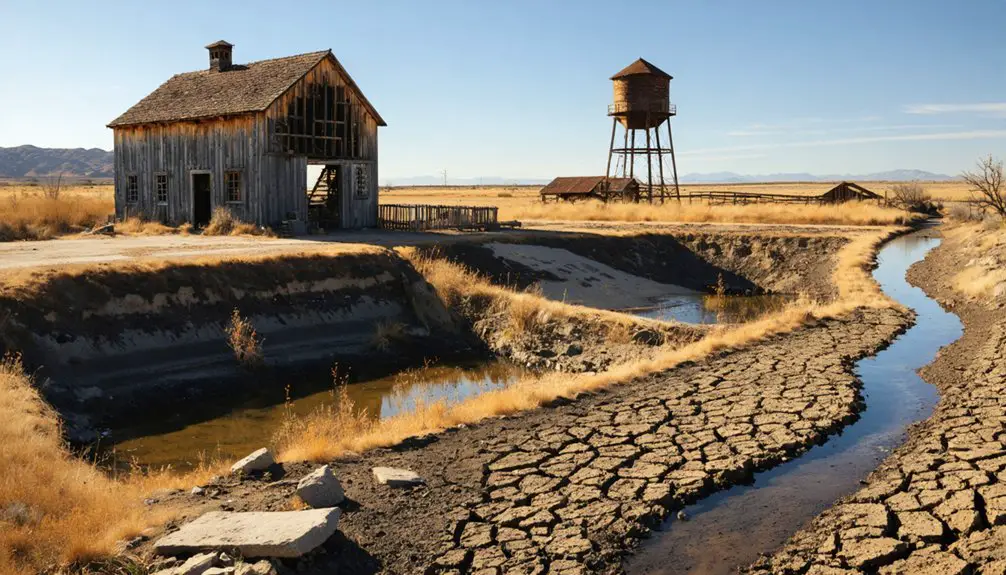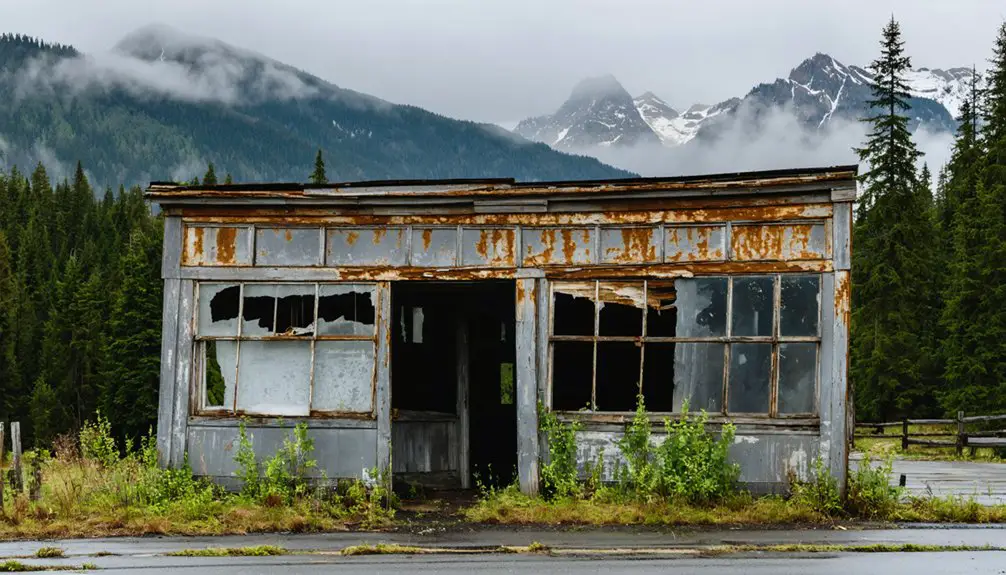You’ll find Lester nestled deep within Tacoma’s restricted watershed, where a bustling railroad community once thrived. Founded in 1891 near Stampede Pass, it grew from a logging camp into an essential Northern Pacific Railway town of 1,000 residents by the 1920s. The town fought against displacement until 1985’s symbolic mock funeral, before Tacoma demolished the remaining structures. Though now a ghost town, Lester’s compelling story of survival and resistance echoes through the wilderness.
Key Takeaways
- Lester became a ghost town after the City of Tacoma purchased and demolished buildings to protect its watershed area in 1967.
- Originally established in 1891 as a railroad town near Stampede Pass, Lester peaked with 1,000 residents during the 1920s.
- The town’s final decline began in the 1950s due to decreased rail service and intensified through legal battles over road access.
- Residents held a symbolic mock funeral in 1985 as their last protest against the town’s forced abandonment.
- Today, Lester exists as a restricted ghost town with no remaining structures, located within Tacoma’s protected watershed territory.
The Rise of a Railroad Town (1891-1908)
When the Northern Pacific Railway established major support facilities near Stampede Pass in 1891, a small logging camp called “Deans” emerged as a critical railroad settlement.
You’ll find the town’s early success stemmed from its strategic position at the foot of the steepest grade, where helper engines were essential for trains crossing the summit.
Like many places in the region with Anglo-Saxon origins, the settlement’s name was changed from Deans to Lester to reflect the English heritage of several founding families.
The town was named after Lester Hansacker, a telegraph operator who worked at the railroad station.
Life Along the Northern Pacific Railway
The Northern Pacific Railway shaped every aspect of life in Lester, transforming a small logging camp into a bustling company town. By the 1920s, you’d find yourself among nearly 1,000 residents, all connected to the railroad dynamics that powered the community’s growth.
The railway company provided everything from worker housing to essential services, creating a self-contained world at the foot of Stampede Pass. Named after telegraph operator Lester Hansacker, the town grew steadily around railway operations. Workers faced demanding ten-hour workdays as the railroad industry resisted implementing shorter shifts.
As you’d witness the daily rhythm of steam locomotives at the roundhouse and coal dock, you’d understand how Lester’s community resilience depended on railway operations.
The large depot, listed on the National Register of Historic Places in 1987, stood as a representation of the town’s significance until its demolition in 1992. Life revolved around the railway’s needs, from worker schedules to housing arrangements.
Economic Boom in Logging and Coal
You’ll find that Lester’s economy surged after 1891 when Dean’s logging camp established operations near the essential Stampede Pass railway route.
The strategic placement along Northern Pacific Railway‘s line transformed the small camp into a bustling town of 1,000 residents by the 1920s, as the railway facilities supported both timber transport and locomotive maintenance. The town was initially named Deans after the lumber company that helped establish it.
Despite a devastating 1902 forest fire that destroyed 30,000 acres of timberland, the combination of logging and railway operations sustained Lester’s growth through its peak years. Forest fires were a common threat to logging communities, as demonstrated by the devastating Big Burn of 1910 that ravaged forests across Montana, Idaho, and Northeast Washington.
Railroad Fuels Town Growth
Following Northern Pacific Railway‘s establishment of Lester in 1891-1892, this strategic railroad stop on Stampede Pass quickly transformed into a bustling hub of economic activity.
The railroad’s significance became evident as essential infrastructure emerged, including a large depot, six-stall roundhouse, machine shop, and coal facilities.
You’d have found a thriving community of railway workers and their families, with the population swelling to nearly 1,000 by the 1920s. The economic interdependence between logging and railroad operations created a perfect storm for growth – Dean’s Lumber Company provided timber while local coal sources fueled the steam locomotives. By 1908, the town had reached 250 residents and was thriving.
The town’s strategic location made it indispensable for maintaining and supplying trains crossing the pass, leading to the development of hotels, stores, and schools to support the booming railway community.
Forest Industry Peak Years
During three pivotal decades spanning 1890-1920, Lester’s forest industry experienced unprecedented growth, transforming a modest logging camp into a thriving industrial center.
You’ll find that Dean’s Lumber Company’s early logging techniques established the foundation for this boom, while Northern Pacific Railway’s steam locomotive facilities at Stampede Pass accelerated economic shifts in the region.
A Town’s Fight for Survival
You’ll find Lester’s community fought tenaciously through legal battles with the City of Tacoma over road access and watershed control from the 1960s through the mid-1980s.
Their struggle against isolation intensified when King County’s attempt to claim the road title failed in 1965, leaving residents increasingly cut off from the outside world.
The town’s determined residents even held a symbolic mock funeral in May 1985, marking their defiant last stand against the forces that would eventually lead to Lester’s complete abandonment. The decline that began in the 1950s rail service ultimately contributed to the town’s inability to maintain its population.
Community’s Last Stand
As the 1960s ushered in legal battles that would determine Lester’s fate, residents found themselves locked in a desperate struggle against the City of Tacoma over road access and water rights.
When court rulings favored Tacoma in 1965, Northern Pacific’s sale of the town site for $37,000 dealt a crushing blow to community resilience.
You’ll find the town’s fighting spirit embodied in figures like Gertrude Murphy, who championed heritage preservation until her death in 2002.
The community’s defiant last stand culminated in a symbolic mock funeral on May 22, 1985, where residents erected a tombstone blaming Governor Gardner and Tacoma for Lester’s demise.
Battling Against Isolation
The fight against isolation in Lester began long before its final days, with the town’s remote mountain location presenting inherent challenges from its 1891 founding.
You’ll find the community’s resilience tested by mounting isolation challenges: Tacoma’s 1960 watershed protection gate severed crucial road access, while the perilous 14-mile logging road over Stampede Pass remained snowbound half the year.
Despite these barriers, residents showed remarkable determination. They battled through legal disputes with Tacoma and King County, fought to preserve their railroad depot, and maintained community spirit through organized events.
Even as the population dwindled below 25 by the 1980s, dedicated citizens like Gertrude Murphy continued advocating for their town’s survival, though ultimately unable to prevent its decline into a ghost town.
The Battle Over Water Rights

Water rights became a flashpoint of contention between Lester residents and the City of Tacoma from the 1960s through the 1980s. The battle centered on Tacoma’s control of the Green River watershed, which they claimed required strict protection for water purity.
Tacoma’s iron grip on the Green River watershed sparked decades of conflict with Lester residents over water rights and control.
After purchasing the town site from Northern Pacific Railway in 1967 for $37,000, Tacoma tightened its grip through legal battles and restrictions.
Here’s how Tacoma systematically dismantled Lester’s autonomy:
- Restricted road access to the town, despite challenges from King County
- Limited residents to non-transferable lifetime leases
- Demolished homes as residents left or died
- Blocked public access to preserve watershed quality
The courts consistently sided with Tacoma’s municipal water interests over residents’ rights, effectively sealing Lester’s fate as a future ghost town.
Final Days and the Mock Funeral
During Lester’s final chapter in May 1985, residents staged a poignant mock funeral that symbolized their town’s defeat by Tacoma’s watershed policies.
You’ll find that attendees gathered around a tombstone declaring “Here lies the town of Lester,” blaming Governor Booth Gardner as Tacoma’s “hired gun” for the community’s demise.
This powerful community protest marked the end of a long decline that began with Northern Pacific’s sale of the townsite to Tacoma in 1967.
You can trace how residents lost their homes as lifetime leases expired, leaving only two inhabitants by 1987.
The most notable was Gertrude Murphy, who remained until her death in 2002 at age 99.
As Lester’s last citizen, she witnessed the final transformation of her beloved town into a restricted watershed area.
After her house burned down, Murphy spent her final years in a small summer cabin until she passed away.
Gertrude Murphy: The Last Guardian

Born in St. Paul in 1903, Gertrude Murphy would become Lester’s most dedicated guardian. After moving to the mountain town in 1929, she quickly demonstrated her unwavering commitment to preserving its legacy.
You’ll find Gertrude’s resilience reflected in her remarkable accomplishments:
- Teaching generations of students in Lester’s one-room schoolhouse
- Fighting to get Lester recognized on Washington’s historic register
- Protecting the 1886 train station until its tragic loss to vandalism
- Continuing to live in “the suburb of Lester” after losing her home in 1993
She was invited to share her unique experiences on David Letterman’s show, though the appearance was ultimately canceled.
Even into her 80s, she championed Lester’s preservation, returning each spring for the clean mountain air.
When she passed at 99 in 2002, the town lost its final resident and most passionate defender, marking Lester’s evolution into a ghost town.
Modern Remnants and Historical Legacy
Today, Lester stands as a restricted ghost town within Tacoma’s Green River watershed, its once-bustling streets now silent and inaccessible to the public.
You’ll find no marked historical preservation efforts or standing structures from this former railroad boomtown – by the early 2000s, Tacoma had demolished or burned the last remaining buildings, including the iconic roundhouse, hotel, and homes.
While remnant discovery is nearly impossible due to strict watershed protection measures, Lester’s legacy lives on through documented accounts of its essential role in Washington’s railroad and logging industries.
At its peak in the 1920s, nearly 1,000 residents called this Northern Pacific Railway service town home.
A bustling mountain community of 1,000 souls, Lester thrived as a vital railroad hub in Washington’s rugged Cascade foothills.
The mock funeral of 1985 symbolized the end of a community that had fought fiercely against displacement, marking Lester’s final shift from thriving town to protected wilderness.
Frequently Asked Questions
Are There Any Reported Ghost Sightings or Paranormal Activity in Lester?
You won’t find documented ghost stories or spectral encounters in Lester. Despite its eerie abandoned atmosphere, there’s no credible evidence of paranormal activity in historical records or contemporary sources.
What Happened to the Bodies in Lester’s Cemetery?
Like silent sentinels, the bodies remain where they were laid to rest. You’ll find no records of cemetery preservation efforts or mass relocations – they’re likely still there beneath weathered wooden crosses in restricted watershed land.
Can Tourists Legally Explore the Abandoned Buildings and Foundations Today?
You can’t legally explore Lester’s remains – it’s strictly off-limits for urban exploration due to watershed protection laws. The area’s guarded, buildings are demolished, and you’ll need special permits for access.
Did Any Major Crimes or Mysterious Events Occur in Lester?
Looking for dark secrets in Lester’s past? You won’t find any documented major crimes or mysterious disappearances. Historical records show the town’s decline was purely due to economic changes and legal battles.
What Natural Disasters, Besides Forest Fires, Affected Lester’s Development?
You’ll find flooding devastated the Green River watershed, while severe storms caused road washouts. The region’s landslides damaged rail lines, and mountain avalanches disrupted transportation. Harsh winters regularly isolated the community.
References
- https://en.wikipedia.org/wiki/Lester
- https://www.historylink.org/File/20841
- https://www.onlyinyourstate.com/experiences/washington/abandoned-town-in-wa
- https://www.abandonedspaces.com/towns/lester-washington.html
- https://www.wta.org/go-hiking/hikes/lester-ghost-town
- https://www.abandonedspaces.com/towns/lester-washington-the-ghost-town-that-no-longer-exists.html
- https://www.instagram.com/p/DDs8DNgJ-cQ/
- https://www.historylink.org/File/21169
- https://en.wikipedia.org/wiki/Lester_Depot
- https://www.historylink.org/File/23257



